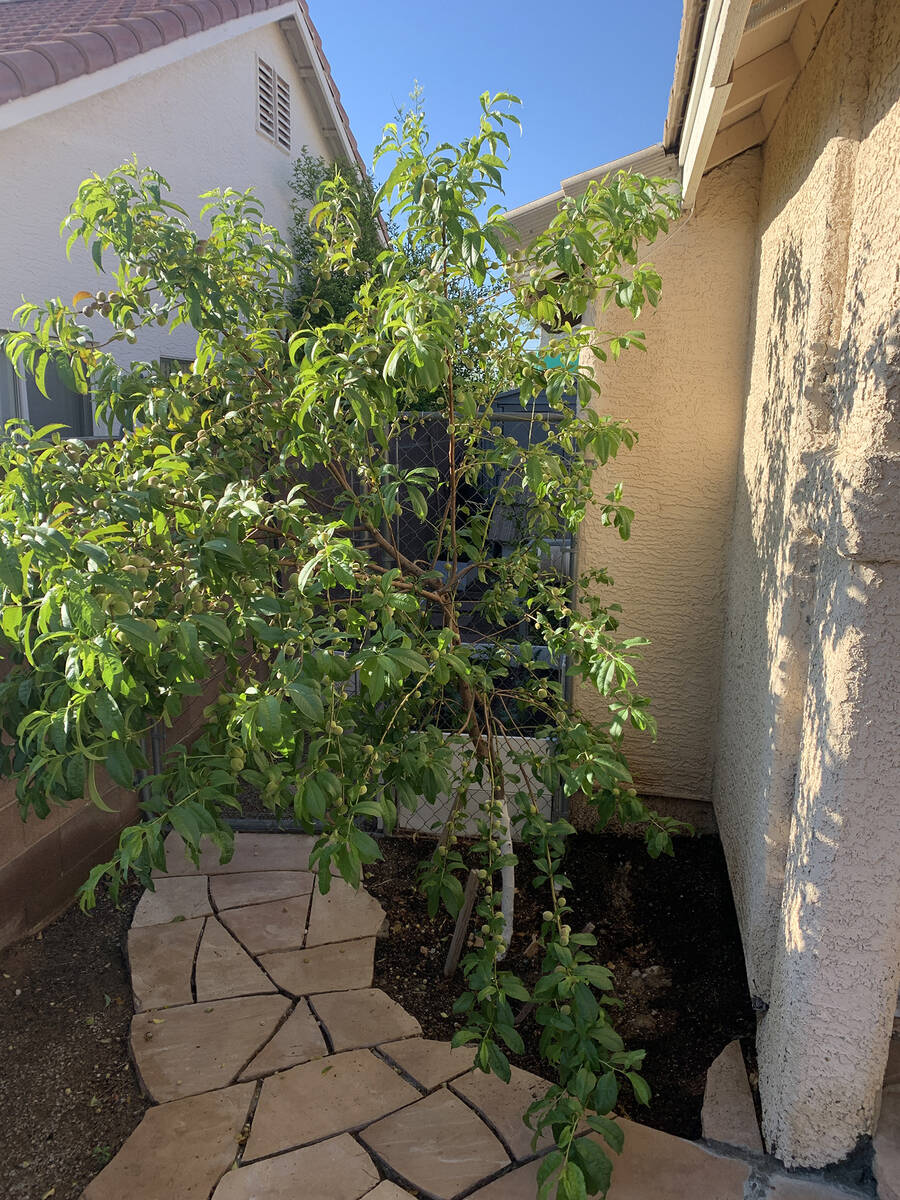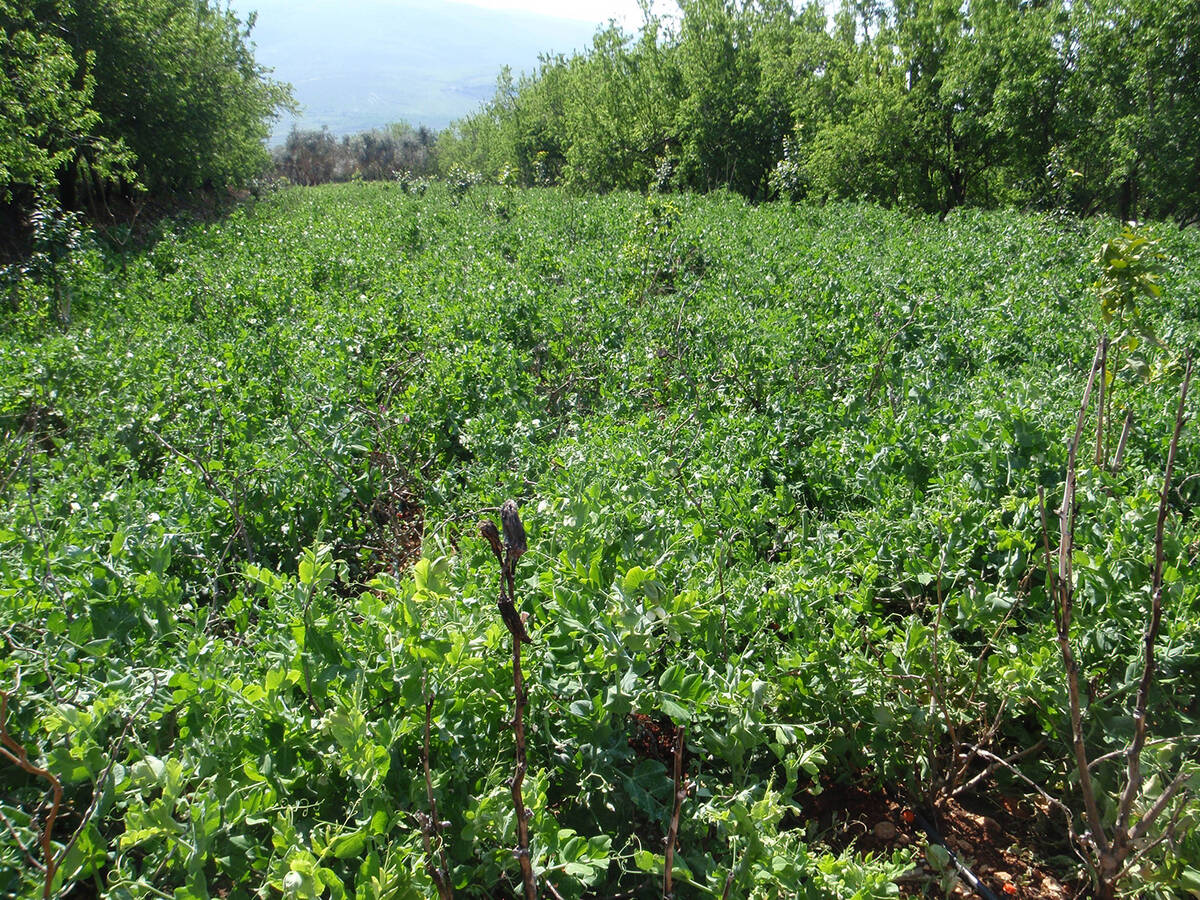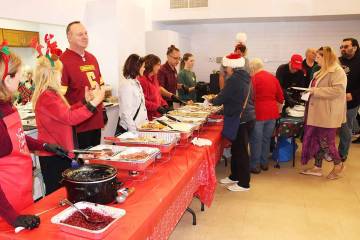Weather, location affects fruit production
Q. I have a Washington navel orange and Flordaprince peach tree planted this spring that a local nursery claimed was eight to 10 years old. The peach tree produced lots of small fruit. The orange tree produced tons of flowers but fruit that dropped from it after it flowered. The trees don’t look so good now. Your opinion please?
A. It sounds like many issues may be involved. Pictures would have helped. As it stands right now there is not much you can do. Some years you will get a good harvest and other years you won’t. That is the nature of the varieties and location in the landscape you selected. Much of your future harvest depends on the weather, fruit tree location and the microclimate of your landscape. That’s the Mojave Desert for you.
Some of these suggestions may work in the future.
Next time select smaller trees with low branching. If there are production issues, then they can be ironed out early. It is important to shade the trunk as quickly as possible when growing fruit trees of any type in the desert. Shading the trunk can be done with its own growth, paint or using a trunk protector.
It’s easier to remove branches that you don’t want than to wish you had them. Our hot desert sun can be very brutal. I am leaning more and more toward leaving the lower branches (below the knee) on fruit trees as long as possible rather than removing them at planting time.
Consider different varieties of fruit trees. Both varieties may not be a wise choice for different reasons. Flordaprince peach is an early producing variety that also flowers very early, about mid-February in our climate. Selecting a variety of peach that produces flowers later gives you a more reliable harvest in our climate due to spring freezes.
Selecting a more cold-tolerant orange type (such as a clementine, aka tangerine) is sometimes a better idea. Selecting a fruit tree that gives you improved tolerance to freezing winter temperatures may be a better idea in the long run than a Washington navel orange, which doesn’t. Selection of a cold-tolerant variety does not help provide a consistent fruit load every year but may help its future survival.
Q. I have a Texas olive tree that may or may not have survived this past winter. We have had the tree for several years now and it has always bloomed and grown. I don’t have any new leaves or blooms except the suckers on the bottom. All our other trees, like our sumac, palo verde and fruit trees are doing fine. But not this one. Is there anything I can do at this point beyond just watching it?
A. That particular tree, Cordia boisieri, is native to the southwest Chihuahuan desert and survives to a winter temperature of about 25 F, around the same winter temperature as Meyer lemon. Because it’s from our desert Southwest it is considered xeric in its water use. Lot of good that does you if it is winter killed or severely damaged.
A better choice might have been another xeric tree from that area such as little leaf cordia, Cordia parvifolia, which seems to survive to a slightly lower winter temperature. I suggest in the future permanent trees in your landscape should have a minimum winter temperature of 20 F.
Suckering from the base is a good indicator it died to the ground, or the trunk was severely damaged. You do not need to replace the tree unless it looks horrible. It is grown on its own roots. Let one or more of the suckers replace what died. Suckers grow very quickly if the roots were not damaged.
If you decide you want to keep it, water deeply and infrequently and fertilize it in the spring. Two handfuls of tree and shrub fertilizer about 2 feet from the tree each year will be enough. Wet the soil, create a slit in the soil with a shovel about 6 to 8 inches deep, drop the fertilizer into the slit, step on it to shut it and water it in. Xeric trees grow rapidly with water applied to them like mesic trees. You will have to search to find this tree at local nurseries.
Q. I planted various fig trees that were very good producers in Southern California — Los Angeles County to be exact. Here they have been planted for over 10 years and I have yet to pick and eat any fruit from any of the trees. The problem that I am experiencing is fruit dropoff. The figs grow to (the size of) a fifty-cent piece and then they drop off.
A. At the University of Nevada Cooperative Extension orchard and elsewhere I grew nearly 12 varieties of figs, and all have done very well. Figs are what I call an “oasis” fruit tree. They handle the heat, do well and produce fruit if water is available.
However, this is the desert. Our desert has two major problems when growing fruit trees like figs: soil improvement and water. Figs produce basically two crops of fruit. These are classed as the “briba” and “main” crops. The briba crop is the earliest because it produces figs on last year’s growth. This is also the crop that fails each year if there is a late spring freeze.
But figs also produce a second crop later in the year called the main crop. This main crop of fruit starts growing late enough in the season that freezing weather has gone. It begins to produce figs early in the season when it starts getting hot. It gets hotter so the tree needs more water to produce its figs. It is confusing because the tree shows no signs it needs water and the leaves look fine. But the figs drop off because the tree needs water.
Those are the keys to successful fig production. Give it a productive soil and apply a 2-3-inch layer of surface mulch. Water it more often in the early summer even though the tree doesn’t look like it needs it.
Q. I planted asparagus at the base of my fruit trees. I can send you pictures if you want.
A. Asparagus is a good thing to interplant with fruit trees, but it should be planted between the fruit trees, not at their base. They have similar watering needs, and their frequency of watering is very similar. That’s important.
There are three things to concern yourself when planting at the base of fruit trees: increasing the amount of water needed, height interference with lower fruit tree branches, and a decrease in light for the asparagus growing under the tree’s canopy. That decrease in light directly affects asparagus production.
Now onto where it should be planted. Plant intercrops between fruit trees rather than around their base. If you do, they will get an increase in the amount of light they receive, and they can grow as tall as they like without interference from lower tree branches. Intercropping like this works well with melons, squash, perennial herbs, perennial fruit and artichokes.
Unless you are using drip tubing you will have to add emitters if grown between trees. Drip tubing (built-in drip emitters) allows the roots of trees to “follow” the water and provides a wet soil for interplanting until the trees start to shade the area.
Q. I bought a house with a palm tree in the backyard. Last year, I noticed little black berries on the ground. This year there are more of them. They start out green and turn black. They are all over the ground. Are they poisonous to pets?
A. These black berries, or palm fruit, are not poisonous to pets to my knowledge. That is not true of tropical or interior palms such as you might find in Florida or grown as houseplants. They can be messy when grown in a landscape or near a pool. They can create a weed problem in the mid to late spring when the seeds germinate.
To remove palm seedlings by hand, wet the soil and in a few hours pull them from the soil when they are about 12 to 18 inches tall.
Bob Morris is a horticulture expert and professor emeritus of the University of Nevada, Las Vegas. Visit his blog at xtremehorticulture.blogspot.com. Send questions to Extremehort@aol.com.












